Tanichthys micagemmae
Etymology
Tanichthys: named for Chinese boy scout leader Tan Kan Fei, who first collected the type species, plus the Greek ἰχθύς (ichthus), meaning ‘fish’.
micagemmae: from the Latin micare, meaning ‘sparkle’, and gemma, meaning ‘jewel’.
Classification
Order: Cypriniformes Family: Cyprinidae
Distribution
To date known only from the Ben Hai river system in north central Vietnam which flows chiefly through the province of Quang Tri.
The type specimens were collected from neighbouring Quang Binh province with the locality given as ‘Stream Bau Dung, a tributary of River Ben Hai, 17°07’24″N, 106°58’12″E, Quang Binh Province, Vietnam’.
Habitat
The type locality was a fast-flowing, shallow stream with sandy substrate and measured around 15 metres across.
The water was clear and T. micagemmae collected only in marginal areas where the flow was considerably reduced.
The majority of the Bau Dung drainage is heavily exploited for rice cultivation, but this particular stream is not as it flows through sand dunes a few kilometers from the coast.
Sympatric fishes included Microcobitis misgurnoides, Yunnanilus cruciatus, Macropodus opercularis, and an unidentified species of Odontobutis.
Maximum Standard Length
20 – 30 mm.
Aquarium SizeTop ↑
Minimum base dimensions of 45 ∗ 30 cm or equivalent are required.
Maintenance
Choice of décor is not especially critical though it tends to show better colouration in a heavily-planted set-up with a dark substrate.
The addition of some floating plants, driftwood roots or branches, and leaf litter also seems to be appreciated and adds a more natural feel.
Filtration does not need to be particularly strong though it does seem to appreciate a degree of water movement and will also do well in a hill stream-type set-up.
Water Conditions
Temperature: 18 – 23 °C
pH: Water parameters at the type locality were not recorded but the fish seem happiest in weakly acidic to neutral conditions with a value around 6.5 – 7.5.
Hardness: Softer water within the range 36 – 143 ppm is preferable.
Diet
Likely to be a micropredator feeding on small insects, worms, crustaceans, and other zooplankton in nature.
In the aquarium it’s easily-fed but the best condition and colours offer regular meals of small live and frozen foods such as bloodworm, Daphnia, and Artemia alongside good quality dried flakes and granules, at least some of which should include additional plant or algal content.
Behaviour and CompatibilityTop ↑
Very peaceful indeed and an ideal resident of the well-maintained community tank although it will not do well with much larger or more boisterous tankmates.
Since it has no special demands in terms of water chemistry it can be combined with many of the most popular fish in the hobby including other small cyprinids as well as tetras, livebearers, dwarf cichlids, catfishes, and loaches.
In a stream-style tank it can be kept with the smaller species of Danio, Devario, and Garra as well as many loaches.
It’s a schooling fish by nature and ideally a group comprising 10+ specimens should be purchased.
Maintaining such numbers will not only make individuals less nervous but result in a more effective, natural-looking display while males will also display their best colours as they compete with one other for female attention.
Sexual Dimorphism
Young specimens can be tricky to sex accurately but mature females are usually rounder-bellied and often a little larger than males.
Males also tend to intensify in colour when in spawning condition or sparring with rivals, and may develop extended dorsal and anal fins with age.
Reproduction
Like many small cyprinids this species is an egg-scattering, continuous spawner that exhibits no parental care.
That is to say when the fish are in good condition they will spawn often and when a group is maintained alone in a densely-planted, mature aquarium or outdoor container small numbers of fry usually start to appear without further intervention.
Should a more controlled approach be required a separate, smaller aquarium can be set up.
This should be dimly-lit and the base covered with some kind of mesh of a large enough grade so that the eggs can fall through but small enough so that the adults cannot reach them.
The widely available plastic ‘grass’-type matting can also be used and works well, as does a layer of glass marbles.
Alternatively filling much of the tank with a fine-leaved plant such as Taxiphyllum spp. or spawning mops can also return decent results.
The water itself should be of slightly acidic to neutral pH with a temperature towards the upper end of the range suggested above, and an air-powered sponge filter or air stone(s) included to provide oxygenation and water movement.
When the adults are well-conditioned and the females appear gravid one or two pairs should then be introduced, and spawning should take place the following morning.
An alternative is to spawn the fish in a group with half a dozen specimens of each sex being a good number, although a larger aquarium may be necessary.
In either situation the adults will probably eat the eggs given the chance and should be removed after 2-3 days maximum.
The eggs should hatch in 48-72 hours and once free-swimming the fry may initially require Paramecium or other microscopic food until large enough to accept Artemia nauplii and suchlike.
NotesTop ↑
This species only became available in the aquarium hobby during the early 21st century but has already achieved a measure of popularity since it’s attractive, easy to maintain and usually quite cheaply-priced.
You may see it on sale under various trade names including ‘Vietnamese minnow’, ‘cardinal minnow’, ‘royal white cloud’, ‘dwarf cardinal’ and others.
We’ve obtained images of what is said to be a naturally-occurring form with extremely elongated fins which may either be a mutation or a trait only seen in older, male individuals.
The genus Tanichthys was monotypic until 2001 when the Vietnamese species T. micagemmae and T. thacbaensis were described.
T. thacbaensis is somewhat enigmatic since its description is written entirely in Vietnamese and accompanied only by a line drawing, with photos of live specimens unavailable to date.
A fourth species, currently known only as T. sp. ‘Vietnam’ appeared in the aquarium trade during 2010 and has been occasionally available in limited numbers.
Among the Tanichthys species available in the hobby the popular congener T. albonubes is noticeably larger than T. micagemmae or T. sp. ‘Vietnam’, exhibits an overall reddish-brown colouration in the body that is lacking in the other two and possesses a less broad dark, lateral stripe on the body, below the paler stripe.
In T. micagemmae the ventral and anal fins are reddish, whereas in T. sp. ‘Vietnam’ they are bright yellow.
T. micagemmae is officially diagnosed by the following: head and body below lateral midline whitish with many small, grey spots; one black and one whitish longitudinal stripe of approximately the same width (width of black stripe 0.9-1.8 times width of whitish stripe); distance from dorsal-fin origin to upper margin of whitish stripe about equal to distance from anal-fin origin to lower margin of black stripe (upper distance 0.9-1.2 times lower distance).
Diagnostic characters for the genus include presence of cornified tubercules on the snout posterior to the premaxila in males, and confluent narial openings.
The phylogenetic position of Tanichthys within the family Cyprinidae is less clear, however.
It has been considered closely related to the genera Danio or Rasbora but recent studies, notably that of Fang et al. (2009) have suggested it to be more analagous withTinca tinca, the common tench, and the putative subfamily Acheilognathinae, better known as the bitterlings.
The results also suggested that T. micagemmae is the parent species of the group in evolutionary terms with T. albonubes its younger relative.
References
- Freyhof, J. and F. Herder , 2001 - Ichthyological Exploration of Freshwaters 12(3): 215-220
Tanichthys micagemmae, a new miniature cyprinid fish from Central Vietnam (Cypriniformes: Cyprinidae). - Fang, F., M. Norén, T. Y. Liao, M. Källersjö, and S. O. Kullander, 2009 - Zoologica Scripta 38(1): 1-20
Molecular phylogenetic interrelationships of the south Asian cyprinid genera Danio, Devario and Microrasbora (Teleostei, Cyprinidae, Danioninae). - Rüber, L, M. Kottelat, H. H. Tan, P. K. L. Ng, and R. Britz, 2007 - BMC Evolutionary Biology 7: 1-10
Evolution of minituarization and the phylogenetic position of Paedocypris, comprising the world's smallest vertebrate.

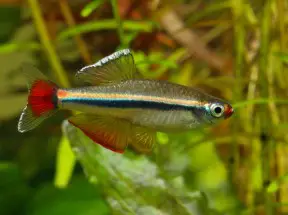


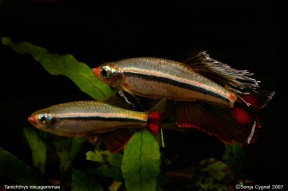
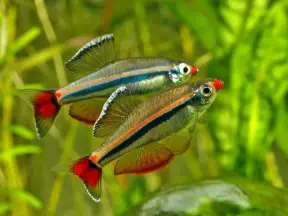

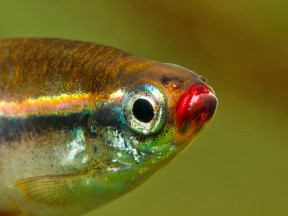


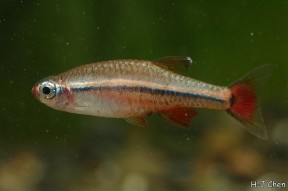
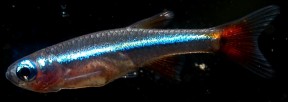

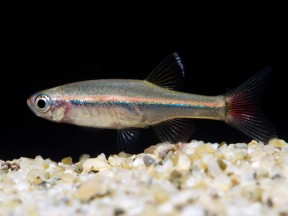
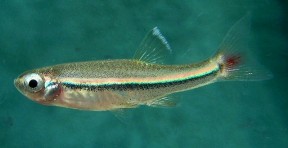

June 27th, 2012 at 9:13 am
It seems that this fish has been observed on an islet near Da Nang, the fourth largest Vietnamese city. So the distribution area of this species is larger than previously thought.
Facts are reported in this thread in a Vietnamese forum:>
<
The coordinates of the islet: 16.221433 North,108.204002 East